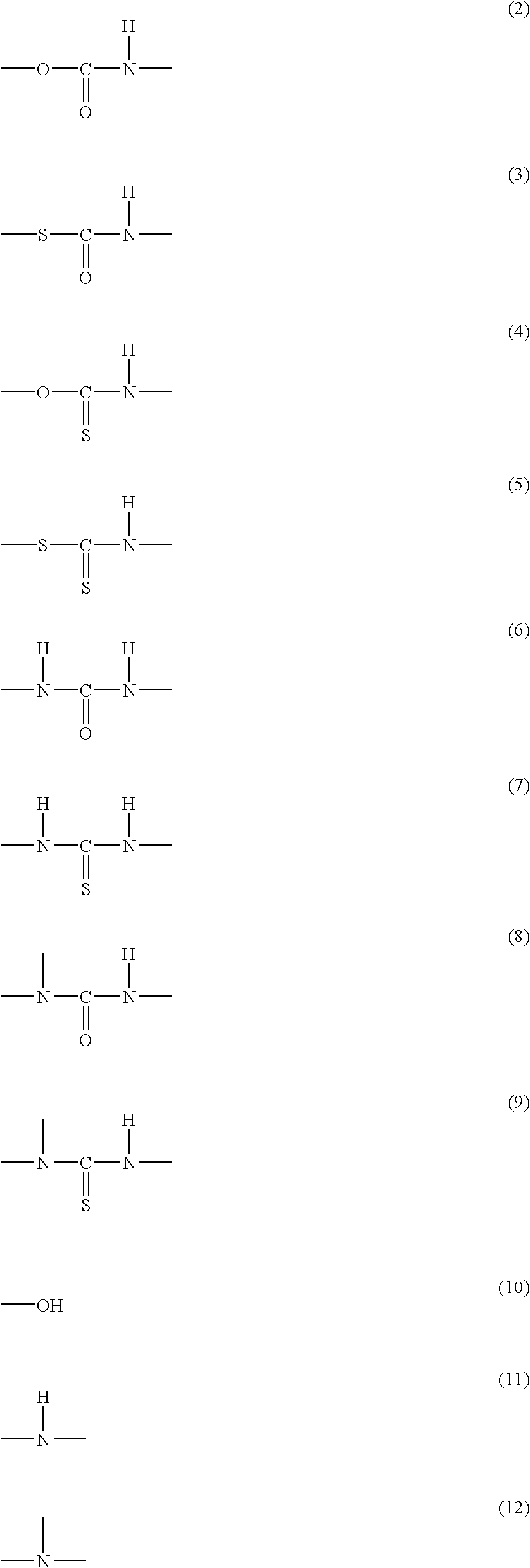Curable resin composition and cold-setting adhesive
a technology of composition and resin, applied in the direction of adhesives, adhesive types, polyurea/polyurethane adhesives, etc., can solve the problems of resin becoming more dangerous and toxic, difficult to blend a large quantity of organic tin compounds, and reducing storage stability
- Summary
- Abstract
- Description
- Claims
- Application Information
AI Technical Summary
Problems solved by technology
Method used
Image
Examples
example 1
Preparative Example 1
[0403] [Preparation of Curable Resin B-1 Having a Trimethoxysilyl Group and a Sulfide Bond in the Molecule]
[0404] In a reaction container placed were 100 g of a polyester having allyl groups at both terminals (trade name: SDX-1690, manufactured by Asahi Denka, number-average molecular weight: 3,000) and 10.3 g of 1,5-dimercapto-3-thiapentane (trade name: DMDS, manufactured by Maruzen Chemical). The mixture was then heated to 90° C. in a nitrogen atmospher. A mixture solution of 0.5 g of AIBN (2,2′-azobisisobutylonitrile) and 5 g of toluene was added dropwise over 1 hour at the same temperature, and the mixture was allowed to react at the same temperature for two hours reaction, to give a compound (PB-1) having a mercapto group in the molecule. The reaction product containing the compound (PB-1) was cooled to 85° C., and 15.6 g of γ-acryloxypropyltrimethoxysilane (trade name: KBM5103, manufactured by Shin-Etsu Chemical) was added and allowed to react at the same ...
example 2
Preparative Example 2
[0405] [Preparation of Curable Resin B-2 Having a Methyldimethoxysilyl Group and a Sulfide Bond in the Molecule]
[0406] With cooling the reaction product containing the compound PB-1 prepared in Preparative Example 1 to 85° C. in a reaction container, 14.6 g of γ-acryloxypropylmethyldimethoxysilane (trade name: KBM5102, manufactured by Shin-Etsu Chemical) was added thereto, and the mixture was allowed to react at the same temperature for 3 hours, to give a curable resin B-2 having a methyldimethoxysilyl group in the molecule that is liquid at room temperature.
example 3
Preparative Example 3
[0407] [Preparation of Curable Resin B-3 Having a Trimethoxysilyl Group, a Urethane Bond and a Substituted Urea Bond in the Molecule]
[0408] In a reaction container placed were 179 g of γ-aminopropyltrimethoxysilane (trade name: KBM903, manufactured by Shin-Etsu Chemical) and 184 g of 2-ethylhexyl acrylate. The mixture was then stirred and allowed to react at 80° C. for 10 hours in a nitrogen atmosphere, to give a reaction product SE-3.
[0409] In another reaction container placed were 700 g of a polyoxypropylene polyol (trade name: PML4010, manufactured by Asahi Glass Urethane, number-average molecular weight: 10,000), 300 g of a polyoxyethylene-containing polyoxypropylene polyol (trade name: PR5007, manufactured by Asahi Denka) and 58.8 g of isophorone diisocyanate (trade name: Desmodule I, manufactured by Sumika Bayer Urethane). The mixture was then stirred and allowed to react at 90° C. for 8 hours in a nitrogen atmospher, to give a polyoxyalkylene resin PB-3 ...
PUM
| Property | Measurement | Unit |
|---|---|---|
| temperature | aaaaa | aaaaa |
| length | aaaaa | aaaaa |
| particle diameter | aaaaa | aaaaa |
Abstract
Description
Claims
Application Information
 Login to View More
Login to View More - R&D
- Intellectual Property
- Life Sciences
- Materials
- Tech Scout
- Unparalleled Data Quality
- Higher Quality Content
- 60% Fewer Hallucinations
Browse by: Latest US Patents, China's latest patents, Technical Efficacy Thesaurus, Application Domain, Technology Topic, Popular Technical Reports.
© 2025 PatSnap. All rights reserved.Legal|Privacy policy|Modern Slavery Act Transparency Statement|Sitemap|About US| Contact US: help@patsnap.com



